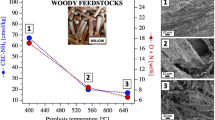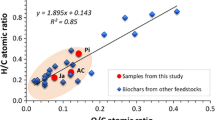Abstract
Recently, biochar was introduced as a bioadsorbent material to remove various contaminants in effluents, such as pigments, dyes, heavy metals, naphthalene, 1-naphthol, atrazine, phosphorus and some macro- and micronutrients. Therefore, biochar of biomass residue pellet obtained for slow pyrolysis was evaluated as an alternative process for the potential utilization as chemical contaminant remover with low cost. Thus, the main objective of this work was to produce biochar from pine residue pellet for subsequent use of the same as a potential adsorbent for effluent treatment. In order to perform the characterization, samples of biochar from pine pellet were produced using several heating rates (5–30 °C min−1), residence temperatures (200, 280 and 570 °C) and residence times (1 h and half an hour). The process adopted led to a rapid degradation of the raw material (pine pellet) associated with an intense generation of volatile compounds, conditions that led to a reduction in density and establishment of porous structure. Biochars had basic character (pH 8.47), predominance of aromatic structures, low moisture content (0.9–1.8 %), low ash content (1.25–1.80 %) and high thermal stability. Low humidity favors the adsorption and an improvement in the conservation during transport and storage.










Similar content being viewed by others
References
Scheer AP, Von Meien OF, de Toledo V, Maciel Filho R, Wolf-Maciel MR. A versatile equilibrium approach applied to adsorption process. AIDIC Conf Ser. 2002;5:285–92.
Nguyen TH, Cho HH, Poster DL, Ball WP. Evidence for a pore-filling mechanism in the adsorption of aromatic hydrocarbons to a natural wood char. Environ Sci Technol. 2007;41:1212–7.
Chun Y, Sheng GY, Chiou CT, Xing BS. Compositions and sorptive properties of crop residue-derived chars. Environ Sci Technol. 2004;38:4649–55.
Bornemann LC, Kookana RS, Welp G. Differential sorption behavior of aromatic hydrocarbons on charcoals prepared at different temperatures from grass and wood. Chemosphere. 2007;67:1033–42.
Chen B, Chen Z. Sorption of naphthalene and 1-naphthol by biochars of orange peels with different pyrolytic temperatures. Chemosphere. 2009;76:127–33.
Chen B, Yuan M. Enhanced sorption of polycyclic aromatic hydrocarbons by soil amended with biochar. J Soils Sediments. 2011;11:62–71.
Shafizadeh F, Sekiguchi Y. Development of aromaticity in cellulosic chars. Carbon. 1983;21:511–6.
Malik PK. Use of activated carbons prepared from sawdust and rice-husk for adsorption of acid dyes: a case study of acid yellow 36. Dyes Pigments. 2003;56:239–49.
Soldatkina LM, Sagaidak EV, Menchuk VV. Adsorption of cationic dyes from aqueous solutions on sunflower husk. J Water Chem Techno. 2009;31:238–43.
Qiu Y, Zheng Z, Zhou Z, Sheng GD. Effectiveness and mechanisms of dye adsorption on a straw-based biochar. Bioresour Technol. 2009;100:5348–51.
Beesley L, Marmiroli M. The immobilization and retention of soluble arsenic, cadmium and zinc by biochar. Environ Pollut. 2011;159:474–80.
Uchimiya M, Lima IM, Klasson KT, Chang SC, Wartelle LH, Rodgers JE. Immobilization of heavy metal ions (Cu-II, Cd-II, Ni-II and Pb-II) by broiler ltter-derived biochars in water and soil. J Agr Food Chem. 2010;58:5538–44.
Mohana D, Pittman CU Jr, Brickab M, Smithc F, Yanceyd B, Mohammadb J, Steelee PH, Alexandre-Francof MF, Gómez-Serranof V, Gongg H. Sorption of arsenic, cadmium, and lead by chars produced from fast pyrolysis of wood and bark during bio-oil production. J Colloid Interf Sci. 2007;310:57–73.
Cao XD, Ma LN, Gao B, Harris W. Dairy-manure derived biochar effectively sorbs lead and atrazine. Environ Sci Technol. 2009;43:3285–91.
Liu Z, Zhang F. Removal of lead from water using biochars prepared from hydrothermal liquefaction of biomass. J Hazard Mater. 2009;167:933–9.
Wilson JA, Pulford ID, Thomas S. Sorption of Cu and Zn by bone charcoal. Environ Geochem Health. 2003;25:51–6.
Mortula M, Gibbons M, Gagnon G. Phosphorus adsorption by naturally-occurring material and industrial by-products. J Environ Eng Sci. 2007;6:157–64.
Bridgwater AV. Renewable fuel and chemicals by thermal processing of biomass. Chem Eng J. 2003;91:87–102.
Barret EP, Joyner LG, Halenda PP. Characterization of Solids in General and Catalysts in Particular. J Am Chem Soc. 1951;73:373–80.
Brunelle JP. Preparation of catalysts by metallic complex adsorption on mineral oxides. Pure Appl Chem. 1978;50(9–10):1211–29.
Guilarduci VVS, Mesquita JP, Martelli PB, Gorgulho HF. Phenol adsorption on commercial active carbon under alkaline conditions. Quim Nova. 2006;29(6):1226–32.
ASTM D792-13. standard test methods for density and specific gravity (relative density) of plastics by displacement, ASTM International, West Conshohocken, PA, 2013.
Oliveira AC, De Carneiro ACO, Vital BR, Almeida W, Pereira BLC, Cardoso MT. Quality parameters of Eucalyptus pellita F. Muell. wood and charcoal. For Sci. 2010;87:431–9.
ASTM D3173-11, Standard test method for moisture in the analysis sample of coal and coke, ASTM International, West Conshohocken, PA, 2011.
ASTM D3174-12, standard test method for ash in the analysis sample of coal and coke from coal, ASTM International, West Conshohocken, PA, 2012.
ASTM D1762-84(2013), Standard test method for chemical analysis of wood charcoal, ASTM International, West Conshohocken, PA, 2013.
Marcilla A, Garcia-Garcia S, Asensio A, Conesa JA. Influence of thermal treatment regime on the density and reactivity of activated carbons from almond shells. Carbon. 2000;38:429–40.
Bridgwater AV. Principles and practice of biomass fast pyrolysis process for liquids. J Anal Appl Pyrol. 1999;51(1–2):3–22.
Bridgwater AV. Review of fast pyrolysis of biomass and product upgrading. Biomass Bioenergy. 2012;38:68–94.
Dermibas A. Pyrolysis of ground beech wood in irregular heating rate conditions. J Anal Appl Pyrol. 2005;73:39–43.
Ranzi E, Cuoci A, Faravelli T, Frassoldati A, Migliavacca G, Pierucci S, Sommariva S. Chemical kinetics of biomass pyrolysis. Energy Fuels. 2008;22:4292–300.
Gracia-Perez M, Wang S, Shen J, Rhodes MJ, Lee WJ, Li CZ. Effects of temperature on the formation of lignin-derived oligomers during the fast pyrolysis of Mallee woody biomass. Energy Fuels. 2008;22:2022–32.
Yang H, Yan R, Chen H, Lee DH, Zheng C. Characteristics of hemicelluloses, cellulose and lignin pyrolysis. Fuel. 2007;86:1781–8.
Antal MJ, Gronli M. The art, science and technology of charcoal production. Eng Chem Res. 2003;42:1619–40.
Morais SAL, Nascimento EA, Melo DC. Chemical analysis of Pinus oocarpa wood part I—quantification of macromolecular components and volatile extractives. Revista Árvore. 2005;29(3):461–70.
Wooten JB, Seeman JI, Hajaligol MR. Observation and characterization of cellulose pyrolysis intermediates by 13C CPMAS NMR. A new mechanistic model. Energy Fuel. 2004;18:1–15.
Ismadji S, Sudaryanto Y, Hartono SB, Setiawan LEK, Ayucitra A. Activated carbon from char obtained from vacuum pyrolysis of teak sawdust: pore structure development and characterization. Bioresour Technol. 2005;96:1364–9.
Sharma RK, Wooten JB, Baliga VL, Lin X, Chan WG, Hajaligol MR. Characterization of chars from pyrolysis of lignin. Fuel. 2004;83:1469–82.
Keiluweit M, Nico PS, Johnson M, Kleber M. Dynamic molecular structure of plant biomass-derived black carbon (biochar). Environ Sci Technol. 2010;44:1247–53.
Lima IM, Marshall WE. Granular activated carbons from broiler manure: physical, chemical and adsorptive properties. Biosour Technol. 2005;96:699–706.
El-Hendawy AA. Surface and adsorptive properties of carbons prepared from biomass. Appl Surf Sci. 2005;252:287–95.
Silverstein RM, Webster FX, Kiemle DJ. Spectrometric identification of organic compounds. 7th ed. Hardcover: Wiley; 2005.
Figueiredo JL, Pereira MFR, Freitas MMA, Órfão JJM. Modification of the surface chemistry of activated carbons. Carbon. 1999;37:1379–89.
Lohmann TW. Modelling of reactions in coal pyrolysis. Ph.D. thesis, Institute of Applied Mathematics and statistics, Munich University of Technology, Munchen, Germany; 2001.
Brewer CE, Schimidt-Rohr K, Satrio JA, Brown RC. Characterization of biochar from fast pyrolysis and gasification systems. Environ Prog Sustain Energy. 2009;28(3):386–96.
Ng C, Losso JN, Marshall WE, Rao RM. Physical and chemical properties of selected agricultural byproduct-based activated carbons and their ability to adsorb geosmin. Biosour Technol. 2002;84:177–85.
Marton JM, Felipe MGA, Silva JBAE, Pessoa Júnior A. Evaluation of activated charcoals and conditions of adsorption on hemicellulosic hydrolyzate treatment of sugarcane bagasse using design of experiments. Analytica. 2003;3:45–54.
Garg VK, Gupta R, Yadav AB, Kumar R. Dye removal from aqueous solution by adsorption on treated sawdust. Bioresour Technol. 2003;89:121–4.
Acknowledgements
The authors acknowledge CAPES for financial support and BrBiomassa Company for pellet samples.
Author information
Authors and Affiliations
Corresponding author
Rights and permissions
About this article
Cite this article
Santos, L.B., Striebeck, M.V., Crespi, M.S. et al. Characterization of biochar of pine pellet. J Therm Anal Calorim 122, 21–32 (2015). https://doi.org/10.1007/s10973-015-4740-8
Received:
Accepted:
Published:
Issue Date:
DOI: https://doi.org/10.1007/s10973-015-4740-8




